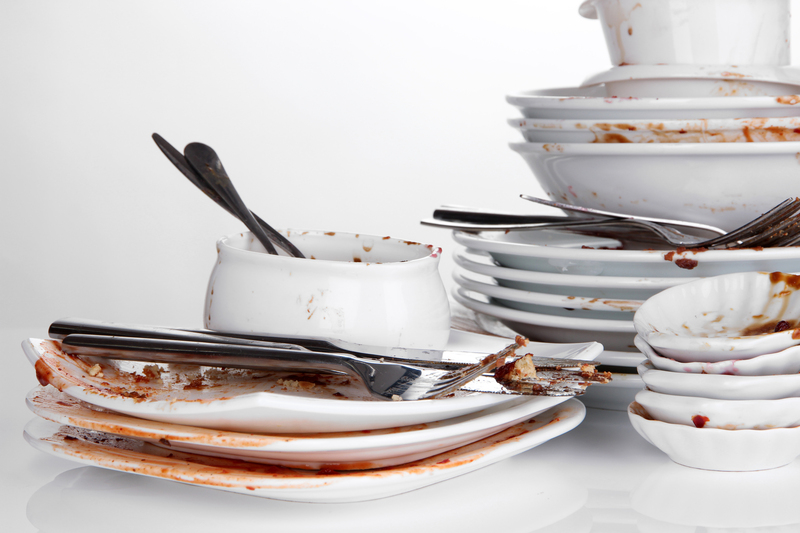Proven Techniques for a Mold-Free Bathroom
Posted on 24/08/2025
Proven Techniques for a Mold-Free Bathroom
A mold-free bathroom isn't just about aesthetics; it's vital for health and comfort. Bathrooms, due to their humidity and warmth, can become breeding grounds for mold and mildew. If left uncontrolled, mold can damage property and trigger health issues such as allergies and respiratory problems. This comprehensive guide details effective, science-backed strategies to keep your bathroom fresh, healthy, and completely mold-free.

Understanding Mold and Why It Loves Bathrooms
Mold is a type of fungus that thrives in moist, warm environments. Bathrooms, with their constant supply of water from showers, baths, and sinks, provide the ideal conditions for mold spores to settle and grow. It often appears as black, green, or brown patches on tiles, grout, ceilings, and even under sinks. Knowing why mold grows in bathrooms is the first step to prevention.
- High humidity from steam
- Poor ventilation
- Residual water after bathing or showering
- Organic matter like soap scum and skin cells (food sources for mold)
*Addressing these issues is the foundation of any mold prevention strategy for bathrooms.*
Effective Ventilation: The First Line of Defense
One of the top techniques for a mold-free bathroom is ensuring proper ventilation. Mold spores require consistent moisture to grow. By eliminating excess humidity, you're making your bathroom inhospitable to mold.
How to Improve Bathroom Ventilation
- Install and use an exhaust fan: Switch it on during and for at least 15-20 minutes after showers or baths to vent steam outside.
- Open windows and doors: If possible, open a window or prop open the bathroom door after use to let fresh air circulate and reduce humidity.
- Regularly clean extractor fans and vents: Dust and debris can block these features, so keep them clean for maximum efficiency.
Tip: Consider upgrading to a humidity-sensing exhaust fan that automatically turns on when moisture levels rise.
Keep Surfaces Dry: Drying Techniques to Prevent Mold
Stagnant water is a mold's best friend. For a mold-resistant bathroom, make it a habit to remove water from common surfaces.
Proactive Drying Methods
- Squeegee shower walls and doors: After every use, run a squeegee over tiles and glass to prevent water droplets from clinging and feeding mold growth.
- Dry counter and sink areas: Use a towel or cloth to wipe down wet surfaces, especially below soap dispensers and toothbrush holders.
- Hang towels and bathmats spread out: Don't leave linens bunched. Spread them to dry quickly, reducing the risk of moldy odors and spores.
Maintaining a dry bathroom environment significantly reduces the likelihood of mold formation.
Routine Cleaning: The Secret to a Mold-Free Shower and Bathroom
*Regular cleaning is your best defense.* By removing soap scum, oils, and organic debris, you deprive mold of the food it needs to grow.
Essential Bathroom Cleaning Tips
- Use mold-inhibiting cleaners: Pick bathroom cleaners that are specifically designed to kill mold and mildew.
- Pay attention to grout and caulk: These porous areas are particularly vulnerable. Scrub grout lines and reapply caulk when it becomes cracked or separates from surfaces.
- Deep clean weekly: Make it a habit to give your bathroom a thorough cleaning every week, focusing on all nooks and crannies where mold commonly develops.
- Don't forget hidden areas: Clean under the sink, behind the toilet, and window sills--areas that often go unnoticed.
A persistent cleaning schedule is crucial for maintaining a truly mold-free environment.
Seal and Repair: Stop Mold Before It Starts
Water leaks and damaged surfaces create perfect pockets for mold to thrive. Regularly inspect your bathroom for problem areas.
Maintenance and Repair Checklist
- Repair dripping faucets and leaky pipes: Even tiny leaks can cause enough moisture for mold growth.
- Replace old, moldy caulk and grout: Once these materials are contaminated or compromised, it's best to remove and redo them for proper sealing.
- Seal all joints and seams: Make sure all connections around the sink, tub, and toilet are watertight.
- Inspect and maintain bathroom fixtures: Regular checks can prevent hidden leaks and water accumulation.
These simple fixes can go a long way toward maintaining a moldless bathroom.
Smart Materials: Choose Mold-Resistant Surfaces and Products
When renovating or building, opt for materials that are mold-resistant. The right choices make future cleaning easier and significantly reduce the risk of mold.
Best Mold-Preventing Materials for Bathrooms
- Mold-resistant drywall (green board): Specifically designed to resist moisture, making it ideal for bathroom walls and ceilings.
- Non-porous tiles and stones: Glazed ceramic, porcelain, or sealed natural stone are far less likely to harbor mold than their unsealed counterparts.
- Epoxy grout: More water-resistant and less porous than traditional grout, which means fewer places for mold to grow.
- Acrylic or fiberglass shower surrounds: These are easier to clean than tiled surfaces and tend to resist mold buildup.
Investing in the right materials results in long-term bathroom mold prevention and less maintenance hassle.
Control Humidity: Keeping Air Moisture Low
Besides ventilation, overall humidity control is essential. Mold thrives when relative humidity is above 60%. Keeping your bathroom air drier discourages mold growth.
Humidity-Reducing Tips
- Use a dehumidifier: Small, portable units work well in bathrooms with persistent moisture issues.
- Leave the shower curtain open to dry: This allows air to circulate and dries the inside of the shower faster.
- Install a humidity meter: Monitor levels to ensure they stay below the ideal threshold (below 50%).
- Remove damp items promptly: Wet clothes, bathmats, or rugs should not linger in the bathroom.
*Maintaining low humidity is a vital component for a permanently mold-free bathroom.*
Natural Remedies for Preventing Mold in Bathrooms
For those who prefer eco-friendly solutions, there are natural methods to keep your bathroom mold-free without harsh chemicals.
Popular Natural Mold Prevention Techniques
- White vinegar: Its acidity kills mold and prevents regrowth. Spray undiluted on problem areas and leave for an hour before scrubbing clean.
- Baking soda: Natural deodorizer and mild abrasive. Mix with water, apply to surfaces, then scrub to remove mildew.
- Tea tree oil: A potent antifungal. Mix a teaspoon with a cup of water in a spray bottle, apply, and leave to dry.
- Hydrogen peroxide: Effective at killing mold. Use 3% solution, spray on spots, and let sit for ten minutes before wiping away.
Using these natural alternatives not only promotes a mold-free environment but also keeps bathroom air safer for your household.
Long-Term Mold Prevention: Habits and Routines
Beyond just techniques and cleaning products, consistent everyday habits are key to keeping bathrooms mold-free for good.
Daily and Weekly Routine Checklist
- Turn on the bathroom fan before and after showers.
- Wipe down wet surfaces after each use.
- Launder towels and bathmats at least once a week.
- Check for leaks under sinks and around fixtures regularly.
- Quickly clean up any visible spots of mold or mildew.
These consistent routines help reinforce all the other proven bathroom mold prevention methods, making mold a rare occurrence rather than a recurring problem.
What to Do If You Already Have Bathroom Mold
If you spot mold in the bathroom, quick action is essential. Small patches (less than 10 square feet) can typically be removed safely with appropriate cleaning solutions. Always wear gloves and a mask when dealing with mold.
Steps for Safe Mold Removal
- Isolate the area: Close off the bathroom to prevent mold spores from spreading.
- Use cleaners designed for mold removal: Apply according to manufacturer instructions.
- Scrub thoroughly: Use a stiff brush to remove all mold from grout, tile, and caulk.
- Dry completely after cleaning: Use fans or open windows to speed drying.
- Replace materials if mold persists: Severely contaminated caulk, grout, or drywall may need to be removed and replaced by a professional.
For major or recurring mold issues, consult a mold remediation professional to assess and address any underlying causes behind persistent growth.

Summary: Enjoy a Truly Mold-Free Bathroom
Achieving and maintaining a mold-free bathroom revolves around three core principles: controlling moisture, using proper materials, and maintaining consistent cleaning habits. By understanding what causes bathroom mold and following the proven techniques outlined here, you can keep your space sparkling clean and healthy.
- Ensure excellent ventilation and reduce humidity.
- Wipe down all wet surfaces after every use.
- Use the right cleaning, caulk, and construction materials.
- Stay vigilant with regular inspection and prompt repairs.
- Incorporate natural or commercial mold prevention as needed.
With these strategies, a mold-free bathroom environment is well within your reach. Take action today and say goodbye to bathroom mold for good!
Frequently Asked Questions on Bathroom Mold Prevention
How often should I clean my bathroom to prevent mold?
It's best to clean high-moisture areas (showers, sinks, tubs) at least once a week with a mold-inhibiting cleaner. Wipe down wet surfaces daily to minimize risk.
What is the best mold remover for bathrooms?
Commercial mold removers with antifungal properties are highly effective. Natural options like white vinegar or hydrogen peroxide also work well for small areas.
How can I keep bathroom grout mold-free?
Seal new grout with a waterproof sealer, clean regularly, and dry grout lines after each shower. Replace old, crumbling grout as soon as possible.
Is bathroom mold dangerous?
Some bathroom molds can cause respiratory issues, allergies, and other health concerns. It's always best to remove even minor mold growth promptly.
For even more proven bathroom mold prevention tips, consult your local home improvement expert or a mold specialist for tailored advice.




